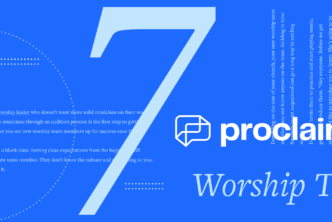“The same way a campfire draws us into conversation and deep thought, on a basic level, abstract animation captures our attention,” says Fred Sprinkle, our motion graphics team lead.
But using animation well isn’t as simple as choosing to use them or not. According to Fred, achieving the right effect is all about timing.
“You want to use it at the right times and in the right places for specific purposes,” he says. “You don’t want it everywhere all the time.”
For Fred, motions are the chocolate sauce of church design.
“Chocolate goes great on banana splits or ice cream, but you’re not going to put it on your steak,” he says. “You’re not going to put icing on your salad.”
When, where, and how you apply motion matters.
“There are certain times in the service where motions add to what you’re already doing,” Fred says. “If you use them at the wrong time though, it subtracts.”
When to use motion graphics
Motion graphics are highly situational. In the right setting, they help your congregation focus on the right things. In the wrong setting, motions can actually hinder people from connecting with your message, your worship service, and—most importantly—God.
As a motion graphics artist, Fred is sensitive to how his work affects people.
“Distractions are a problem in the church,” Fred says. “We don’t want to add to that. A lot of people have experienced uses of motion that were distracting or uncomfortable. We have a responsibility to use motion the right way.”
Finding the right ways to use motion graphics in your service starts with understanding how they function in a church setting.
“Motion graphics are great for adding energy to the parts of the service that make sense—like worship,” Fred says. “The choice you have to make with motion is when do you want people’s attention to be on the screen. When do you want their attention not to be on the screen?”
While Fred and his team work hard to create meaningful art for the church, the responsibility to decide how that art is used ultimately resides with the pastors, audio-visual teams, and church volunteers who actually implement motions in their services.
“Before you start creating your presentation, you want to consider which parts of the service lend themselves to motion,” Fred says. “Motion works well during the high-energy parts of your service, like worship, or in the background before and after the service.” In the middle of your sermon or while someone is talking, motion graphics are almost guaranteed to be distracting.
Similarly, if the motion you choose isn’t aligned with the other design elements of your service—lighting, sound, stage design, the words on the screen, or even the tone of the person speaking—it’s distracting.
“If you have a small church, or you meet in a living room, having some huge countdown animation with loud music playing obviously isn’t appropriate,” Fred says. “In a big church there’s so much space, motions aren’t distracting, and they draw your attention to the part of the room you want them to pay attention to.”
But choosing to use motions or not isn’t just about the physical space your church occupies.
“It’s so dependent on church culture. Some churches, the way the service goes, the church is engaged in passionate worship for two thirds of the service. And maybe for them, it makes sense to keep the motions coming.”
How motion graphics affect moods
“Churches are already thinking about setting the mood each week, whether they know it or not,” Fred says. “They’re already thinking about when to dim the lights, when to use candles—if they do that—and what kinds of songs to choose. Motions are just one more piece of that.”
It takes a coordinated effort to align your church design each week—and probably, you’re already doing that.
“Some motions are really subtle, and they affect mood in kind of the same way that a fish tank can reduce stress,” Fred says. “You don’t really notice it or focus on it, but you sort of feel it.”
Different motions create different moods.
“Some motions pump people up, and some are relaxing,” he says. “People love natural scenes in motion, like waves on a seashore.”
Where church media is heading
Not all churches have embraced motion graphics, mini-movies, or sermon illustration videos. But broadly speaking, how churches use media is evolving rapidly.
“I see the use of motion and movies in church becoming more thoughtful,” Fred says. “Videos are no longer a novelty that people put in for the sake of novelty. They’re added for a reason—to be helpful to people. Churches have to use video intentionally, not just ‘because we can.'”
Why artists love motion videos
“I love being able to capture people’s emotions, tell a story, and make things that are beautiful,” Fred says. “A few years ago, I got to make this Psalm 23 piece. I love being able to use music and animation to move people.”
See it for yourself:
* * *
If you enjoy the Bible animations that Fred and his team produce, you can share them with your congregation and add them to your presentations in Proclaim. To get complete access to all the motion graphics Fred and his team produce, check out Pro Media.




